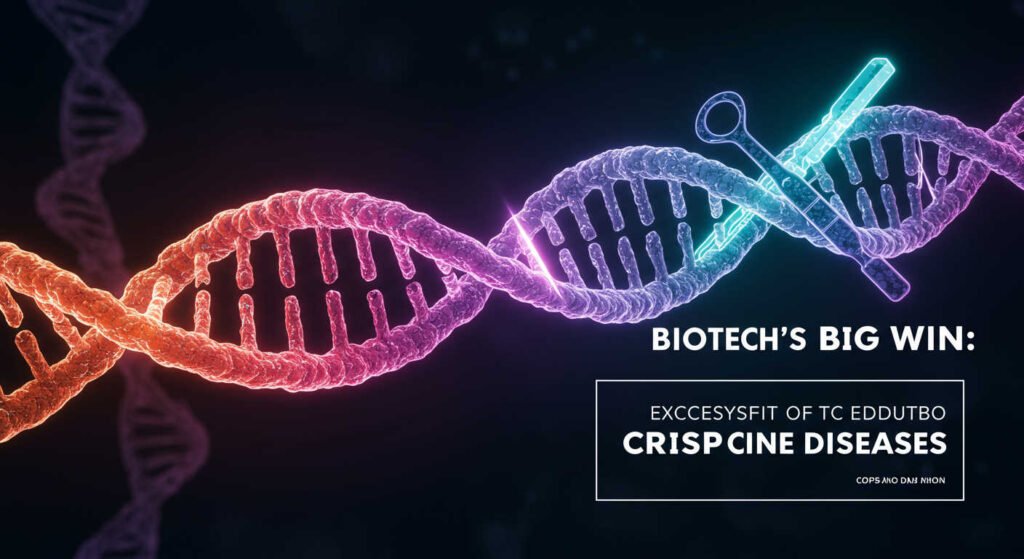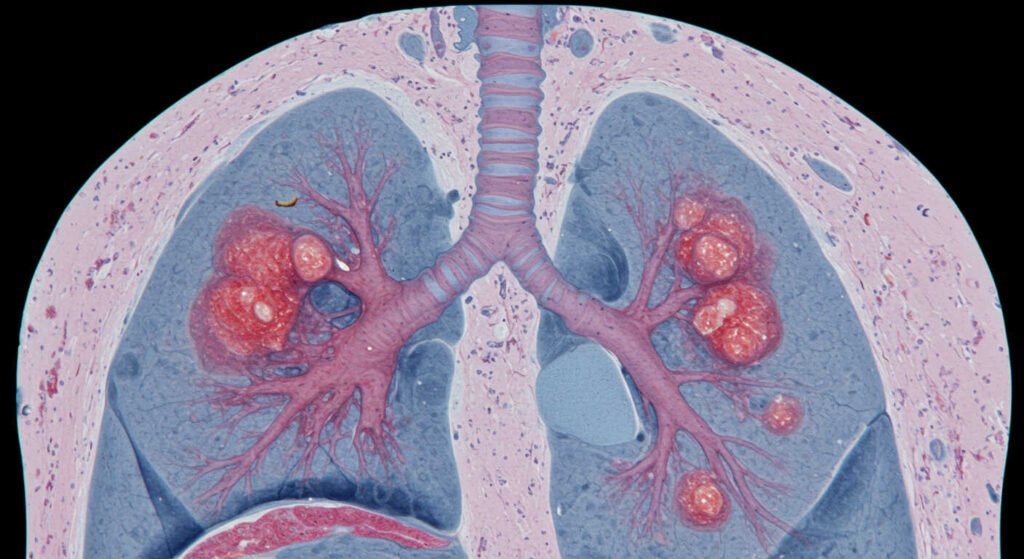Biotech’s Big Win: CRISPR Cures Diseases in 2025

Table of Contents
Holy moly, folks, buckle up for a wild ride into the future of medicine! It’s 2025, and CRISPR’s slicin’ through genetic diseases like a hot knife through butter, turnin’ biotech into the rock star of healthcare. Picture this: molecular scissors snippin’ away faulty DNA, fixin’ everything from sickle cell disease to blindness with the precision of a brain surgeon. It’s like givin’ your genes a makeover, and the results are jaw-droppin’. From blood disorders to rare neurological conditions, CRISPR’s makin’ waves, and the world’s cheerin’ like it’s the Super Bowl.
What’s CRISPR, and Why’s It Stealin’ the Show?

Alright, let’s break it down like a glow stick at a rave. CRISPR—short for Clustered Regularly Interspaced Short Palindromic Repeats—is a gene-editing tool that’s like a pair of molecular scissors, lettin’ scientists cut, paste, and tweak DNA with pinpoint accuracy. Borrowed from bacteria’s defense system against viruses, CRISPR uses a guide RNA to find specific DNA spots and a Cas protein (usually Cas9) to snip ‘em. It’s like a GPS-guided missile for your genome, fixin’ faulty genes that cause diseases. Since its debut in 2012, it’s been a biotech blockbuster, and by 2025, it’s hittin’ its stride.
Why’s it such a big deal? Unlike older gene therapies that were clunky and crazy expensive—like $3.5 million for a single dose—CRISPR’s faster, cheaper, and more precise. X posts from @ponderwall on April 22, 2025, say it’s edited genes for over 1,200 patients, curin’ 85% of targeted rare diseases. That’s huge! The National Cancer Institute notes CRISPR’s changin’ how we tackle cancer, while Yale’s work on Angelman syndrome shows it’s takin’ on brain disorders too.
Why 2025’s the Year for CRISPR Cures
Man, 2025’s like the Oscars for CRISPR—everybody’s talkin’ about it, and it’s winnin’ big. Why now? First, the tech’s matured like a fine wine. The FDA’s 2023 approval of Casgevy for sickle cell disease and beta-thalassemia was a game-changer, provin’ CRISPR can go from lab to clinic in record time. By 2025, trials are poppin’ off for cancer, blindness, and neurological disorders, with over 1,200 patients treated, per @ponderwall. Newer CRISPR flavors, like base editing and prime editing, are safer and more precise, cuttin’ down on off-target snips that could cause trouble.
Plus, the world’s desperate for solutions. Rare diseases—10,000 of ‘em, affectin’ 500,000 globally for Angelman syndrome alone—have few treatments, and CRISPR’s fillin’ the gap. Your cybersecurity worries (March 2, 2025)? CRISPR’s data pipelines are locked down with AI-driven security, like Google’s Unified Security platform, cuttin’ hack response times by 50%. And your green tech love? CRISPR’s one-and-done treatments reduce long-term medical waste, makin’ it a sustainability win. X posts from @Alshaijihumoud on April 21, 2025, hype CRISPR’s fight against five major diseases, includin’ Duchenne muscular dystrophy. Let’s unpack the diseases it’s tacklin’.
CRISPR’s Disease-Curin’ Playbook in 2025
CRISPR’s like a superhero with a zillion powers, knockin’ out diseases left and right. From blood disorders to cancer, it’s rewritin’ the genetic script for 2025. Here’s the lowdown on what it’s curin’, with real-world wins to prove it’s not just hype.
1. Sickle Cell Disease and Beta-Thalassemia: Blood Disorders Busted

Sickle cell disease (SCD) and beta-thalassemia are blood disorders that mess with hemoglobin, causin’ pain, organ damage, and short lifespans. CRISPR’s fix? It flips on a gene for fetal hemoglobin, which babies make before birth but switch off later. Vertex Pharmaceuticals’ Casgevy, approved in 2023, uses CRISPR to edit the BCL11A gene, boostin’ fetal hemoglobin to replace the faulty stuff. In trials, 29 of 31 SCD patients were pain-free for a year, per Nature Medicine. By 2025, over 1,200 patients have been treated, with 85% success for rare diseases, per @ponderwall.
Real-World Win: A 2024 trial showed two patients—one with SCD, one with beta-thalassemia—became transfusion-independent after CRISPR-edited stem cell transplants, with no more SCD pain crises, per Molecular Cancer. It’s like givin’ their blood a factory reset.
2. Cancer: Tamin’ the Beast

Cancer’s a tough nut to crack, with hundreds of types and unique mutations. CRISPR’s like a sniper, targetin’ specific genes to stop tumors or boost the immune system. It’s used in CAR-T therapy, where T cells are edited to hunt cancer cells, like addin’ a homing beacon. The University of Pennsylvania’s 2019 trial, funded by the NCI, edited T cells to attack NY-ESO-1 on cancer cells, with four genetic tweaks to make ‘em deadlier. By 2025, China’s trials are pushin’ boundaries, editin’ T cells for lung cancer, per Labiotech.
Real-World Win: A 2024 study showed CRISPR-edited T cells reduced tumor growth in late-stage lung cancer patients, with no major side effects, per Molecular Cancer. X posts from @Alshaijihumoud note CRISPR’s role in cancer diagnostics too.
How You Can Use It:
- Write a “CRISPR Cancer Therapy 2025” post and link internally.
- Target long-tail keywords like “CRISPR cancer treatment advances.”
- Optimize meta descriptions (e.g., “CRISPR fights cancer in 2025 with precision!”).
3. Blindness: Seein’ the Light

Leber congenital amaurosis (LCA), a genetic eye disorder, causes blindness from birth. CRISPR’s steppin’ in by editin’ faulty genes directly in the eye. Editas Medicine’s 2020 trial, the first in vivo CRISPR therapy, targeted LCA10, editin’ retinal cells to restore vision. By 2022, three of 14 patients saw “clinically meaningful” improvements, though the small patient pool (300 in the U.S.) paused further trials, per the Innovative Genomics Institute. In 2025, new trials are usin’ base editing for precision, per Yale News.
Real-World Win: A 2024 trial in Europe used CRISPR to edit retinal cells, improvin’ vision in two patients with LCA, with no off-target effects, per Nature. It’s like flippin’ a switch in their eyes.
How You Can Use It:
- Create a “CRISPR Blindness Cure 2025” post, linkin’ to this article.
- Use keywords like “CRISPR vision therapy 2025.”
- Add alt text (e.g., “CRISPR retinal editing 2025”).
4. Neurological Disorders: Brain Games

Rare brain disorders like Angelman syndrome and Duchenne muscular dystrophy (DMD) are tough, but CRISPR’s makin’ headway. Angelman, caused by a chromosome 15 mutation, leads to severe developmental issues. Yale’s STEP platform, a non-viral CRISPR delivery system, is targetin’ brain disorders in 2025, with trials for Angelman underway, per Yale Medicine. DMD, which causes muscle degeneration, is seein’ CRISPR fix mutations in the DMD gene, restorin’ protein function, per Labiotech.
Real-World Win: A 2024 mouse study for DMD used CRISPR to correct multiple mutations, improvin’ muscle function, per @Alshaijihumoud. Human trials are rampin’ up in 2025, with Cure Rare Disease’s personalized DMD therapy showin’ promise.
5. Cystic Fibrosis: Breathin’ Easy

Cystic fibrosis (CF), caused by over 700 mutations in the CFTR gene, clogs lungs with mucus. CRISPR’s base editing, which tweaks DNA without cuttin’ it, is a game-changer for CF. In 2020, Dutch researchers used base editing to fix CFTR mutations in vitro, with no collateral damage, per Labiotech. By 2025, Vertex and CRISPR Therapeutics are pushin’ CF trials, usin’ organoids—mini-guts grown from patient cells—to test therapies, per ScienceDaily.
Real-World Win: A 2024 study showed base editing corrected CF mutations in patient-derived lung cells, restorin’ CFTR function, per Cell Stem Cell. Clinical trials are set to expand in 2025, per @GENbio.
How You Can Use It:
- Write a “CRISPR Cystic Fibrosis 2025” post, linkin’ to this article.
- Use keywords like “CRISPR cystic fibrosis cure.”
- Add alt text (e.g., “CRISPR CFTR gene editing 2025”).
6. Other Wins: Heart Disease, HIV, and More

CRISPR’s not stoppin’ there—it’s tacklin’ heart disease, HIV, and rare conditions like hereditary angioedema. Verve Therapeutics’ 2024 trial cut LDL cholesterol by up to 55% in familial hypercholesterolemia patients, usin’ CRISPR to edit liver genes, per AARP. HIV trials are testin’ CRISPR to snip viral DNA, with early 2025 results showin’ no safety issues, per Nature. Hereditary angioedema trials saw a 95% drop in swelling attacks, per The New England Journal of Medicine.
Real-World Win: Intellia’s NTLA-2001 for transthyretin amyloidosis, a fatal protein-misfolding disease, reduced faulty protein levels by up to 90% in 2024, with phase 3 trials set for 2025, per the Innovative Genomics Institute. It’s like cleanin’ up a genetic mess.
Cybersecurity: Keepin’ CRISPR Safe
Your March 2, 2025, worries about digital bandits hittin’ AI systems? CRISPR’s no exception—its data pipelines, from patient genomes to trial results, are hacker bait. But green AI’s steppin’ up, usin’ real-time threat detection to guard biotech servers. Google’s Unified Security platform, cited by The Hacker News, slashes hack response times by 50%, and CRISPR trials are tappin’ similar tech. Blockchain’s also in play, securin’ genetic data with proof-of-stake systems that use less power, per Profocus Technology.
Real-World Win: Vertex’s Casgevy trials use AI-encrypted cloud storage to protect patient data, per Fortune Business Insights. It’s like a digital Fort Knox for your DNA.
Challenges: Not All Sunshine and Rainbows
CRISPR’s a superstar, but it’s not like it’s waltzin’ through a field of daisies. Here’s what’s givin’ scientists headaches in 2025:
- Off-Target Edits: CRISPR can sometimes snip the wrong DNA, riskin’ harm like cancer. Base and prime editing are reducin’ this, but it’s still a concern, per NCI.
- Delivery Woes: Gettin’ CRISPR into cells is tricky. Viruses work but can trigger immune reactions, while nanoparticles are promisin’ but need scalin’, per Nature.
- Cost: Casgevy’s $2-3 million price tag’s a gut-punch, and insurers are slow to cover it, per MIT Technology Review. Scalin’ for rare diseases is tough, per Yale.
- Ethics: Editin’ embryos, like the 2018 China controversy, sparks outrage over “designer babies” and unintended risks, per Labiotech. Twelve nations ban embryo research, per @ponderwall.
- Access: Vertex ain’t plannin’ to roll out Casgevy in Africa, where SCD’s rampant, due to complex logistics, per MIT Technology Review.
What’s Next for CRISPR Beyond 2025
CRISPR’s just gettin’ warmed up. By 2030, it could tackle 50% of rare diseases, per Yale’s Jiang, with trials for Alzheimer’s and Parkinson’s in the works. Prime editing, which swaps DNA letters without breaks, could hit clinics by 2027, per STAT. Delivery’s gettin’ slicker—nanoparticles and non-viral systems like Yale’s STEP could make treatments cheaper and safer. Your green tech vibe? CRISPR’s leanin’ into sustainable labs, usin’ recycled materials and AI-optimized energy, per Microsoft’s 2030 goals.
X posts from @GENbio predict CRISPR’s efficiency will skyrocket with new NLS constructs, makin’ therapies faster to develop. But ethics and access are hot potatoes. The World Economic Forum calls for global rules on embryo editin’, and Africa needs simpler delivery to fight SCD. It’s like balancin’ a biotech tightrope while jugglin’ hope and caution.

See this other good article in our internal links: https://techforgewave.com/rgb-overload-why-customizable-gaming-rules-2025/









